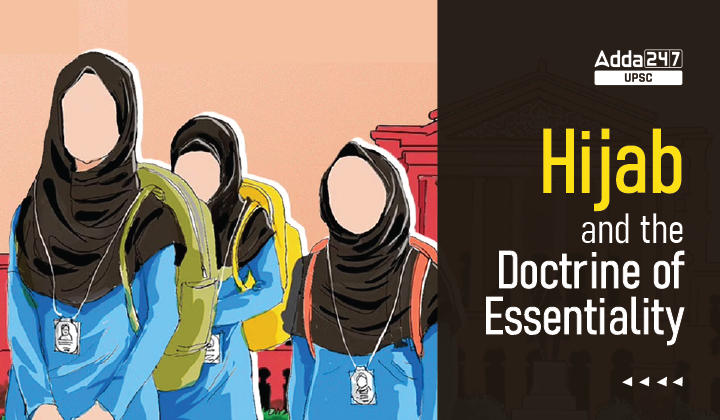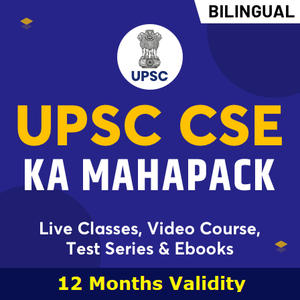Table of Contents
Hijab and the Doctrine of Essentiality- Relevance for UPSC Exam
General Studies II- Executive & Judiciary,Indian Constitution – historical underpinnings, evolution, features, amendments, significant provisions and basic structureExecutive & Judiciary,Indian Constitution – historical underpinnings, evolution, features, amendments, significant provisions and basic structure
Context
- A two-judge Bench of the Supreme Court of India is presently hearing arguments on the correctness of a Karnataka High Court judgment that upheld the ban on the use of the hijab by students in Karnataka which raises question on doctrine of essentiality.
What is ‘Doctrine of Essentiality’?
- A seven-judge Bench of the Supreme Court invented the doctrine of “essentiality” in the Shirur Mutt case in 1954. The court held that the term “religion” will cover all rituals and practices “integral” to a religion.
Doctrine of Essentiality: Importance
In the legal framework, the doctrine of essentiality is a doctrine that has evolved to protect the religious practices that are essential or integral and does not violate any fundamental right. India being a secular country has discrete religious beliefs and to deny any is to violate the freedom of religion.
Is hijab essential?
- Wearing of hijab (head scarf) by Muslim women does not form a part of essential religious practices in Islamic faith and it is not protected under the right to freedom of religion guaranteed under Article 25 of the Constitution of India, the High Court of Karnataka declared on March 15 2022.
- The Qur’an instructs Muslim women and men to dress modestly, and for some, the hijab is worn by Muslim girls and women to maintain modesty and privacy from unrelated males. According to the Encyclopedia of Islam and Muslim World, modesty concerns both men’s and women’s “gaze, gait, garments, and genitalia”.
Identifying Essential religion practice
- The Court observed that in order to determine whether or not a particular practice is an essential part of religion, the test must be whether the absence of the practice itself
Examples of the essential religious practices test
- While these issues are largely understood to be community-based, there are instances in which the court has applied the test to individual freedoms as well.
- In a 2004 ruling, the Supreme Court held that the Ananda Marga sect had no fundamental right to perform the Tandava dance in public streets since it did not constitute an essential religious practice of the sect.
- For example, in 2016, the Supreme Court upheld the discharge of an airman from the Indian Air Force for keeping a beard.
- It distinguished the case of a Muslim airman from that of Sikhs who are allowed to keep a beard.
- In 2015, the Supreme Court restored the Jain religious practice of Santhara/Sallekhana (a ritualistic fast unto death) by staying an order of the Rajasthan HC.
Article 26
- Freedom to manage religious affairs Subject to public order, morality and health, every religious denomination or any section thereof shall have the right.
Supreme Court’s judgement on Doctrine of Essentiality
- The doctrine of “essentiality” was invented by a seven-judge Bench of the Supreme Court in the ‘Shirur Mutt’ case in 1954.
- It is a contentious doctrine evolved by the court to protect only such religious practices which were essential and integral to the religion.
- The court held that the term “religion” will cover all rituals and practices “integral” to a religion, and took upon itself the responsibility of determining the essential and non-essential practices of a religion.
- Referring to the Ayodhya case, the Constitution Bench had ruled in 1994 that A mosque is not an essential part of the practice of the religion of Islam and namaz (prayer) by Muslims can be offered anywhere, even in open.
Arguments over Doctrine of Essentiality
- The ‘essentiality doctrine’ of the Supreme Court has been criticized by several constitutional experts.
- Scholars of constitutional law have argued that the essentiality/integrality doctrine has tended to lead the court into an area that is beyond its competence, and given judges the power to decide purely religious questions.
- As a result, over the years, courts have been inconsistent on this question — in some cases they have relied on religious texts to determine essentiality.
- In others it relied on the empirical behaviour of followers, and in yet others, based on whether the practice existed at the time the religion originated.
Issues
- In the beginning, the court engaged with the question of whether untouchability, manifested in restrictions on entry into temples, was an “essential part of the Hindu religion”.
- After examining selected Hindu texts, it came to the conclusion that untouchability was not an essential Hindu practice.
- The idea of providing constitutional protection only to those elements of religion which the court considers “essential” is problematic as it assumes that one element or practice of religion is independent of other elements or practices.
- So, while the essentiality test privileges certain practices over others, it is, in fact, all practices taken together that constitute a religion.
Effect on society
- Narrowing of safeguards to religious customs: It has allowed the Court to narrow the extent of safeguards available to religious customs by directly impinging on the autonomy of groups to decide for themselves what they deem valuable, violating, in the process, their right to ethical independence.
- Negated legislation that might otherwise enhance the cause of social justice: It has also negated legislation that might otherwise enhance the cause of social justice by holding that such laws cannot under any circumstances encroach on matters integral to the practice of a religion. For example, in 1962, the Court struck down a Bombay law that prohibited excommunications made by the Dai of the Dawoodi Bohra community when it held that the power to excommunicate is an essential facet of faith and that any measure aimed at social welfare cannot reform a religion out of its existence.
- A principle of anti-exclusion: Its application would require the Court to presume that a practice asserted by a religious group is, in fact, essential to the proponents of its faith. But regardless of such grounding, the Constitution will not offer protection to the practice if it excludes people on grounds of caste, gender, or other discriminatory criteria.
Conclusion
- For now, any Court hearing a matter touching upon a matter of faith has the unenviable task of acting not merely as an expert on law but also as an expert on religion.




 TSPSC Group 1 Question Paper 2024, Downl...
TSPSC Group 1 Question Paper 2024, Downl...
 TSPSC Group 1 Answer key 2024 Out, Downl...
TSPSC Group 1 Answer key 2024 Out, Downl...
 UPSC Prelims 2024 Question Paper, Downlo...
UPSC Prelims 2024 Question Paper, Downlo...
